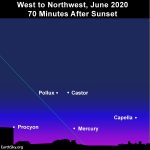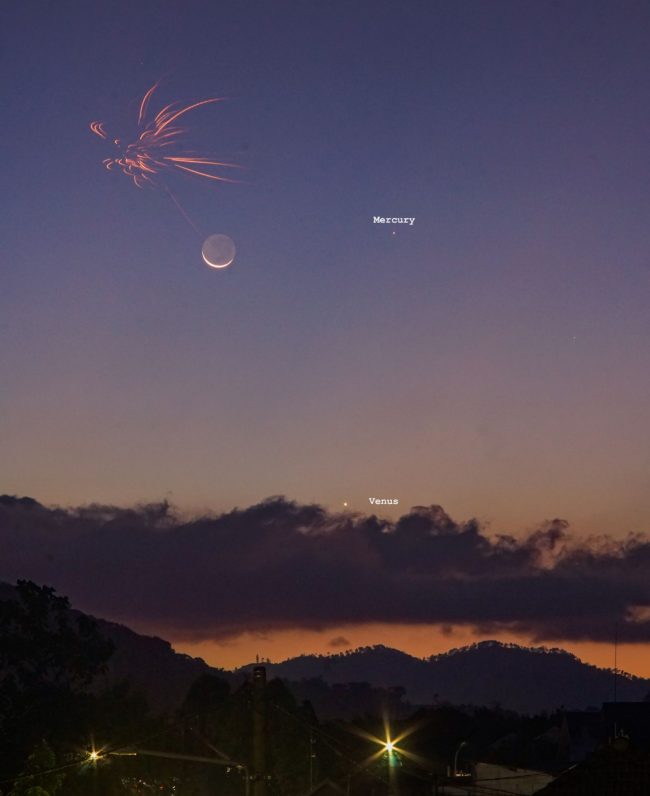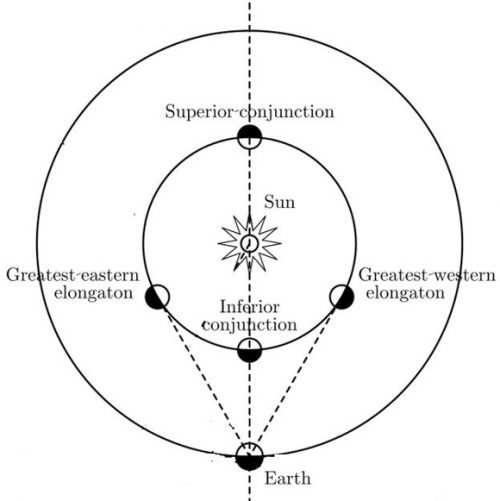
Mercury will reach a milestone in the evening sky – its greatest elongation – or maximum angular distance east of the sun (24 degrees) on June 4 (closer to the evening of June 3 for the Americas). Look for Mercury in the west after sundown. In early June, the planet is roughly midway between two bright stars, Capella and Procyon. The planet and these two stars are roughly the same brightness.
Because Mercury is farthest from the sunset in early June 2020, you’d think this is the best time to see it. Alas, it was easier to spot around May 21 and 22, when the dazzling planet Venus paired up with Mercury. At that time, you could use Venus to find Mercury, plus Mercury was nearly three times brighter than it is at present. Several days after the Mercury-Venus conjunction, the young moon appeared in the sky, and its illuminated side pointed right at Mercury on May 24 and 25.
By June 3 – the date of Mercury’s greatest elongation – Venus is at inferior conjunction, passing more or less between the Earth and sun, transitioning out of our evening sky and into our morning sky. Watch for Venus in the east before dawn, beginning about a week from now. And the moon has gone onward; the June 3 moon is in a waxing gibbous phase, bright in the sky when the sun goes down, but nowhere near Mercury.

View at EarthSky Community Photos. | Venus and Mercury’s “glory days” were around May 24, when both were visible in the west after sunset and the young moon swept through. That’s when Yusha Alfa in Malang, East Java, Indonesia, captured them with these fireworks. Thank you, Yusha! See more young moon, Venus and Mercury photos.
So we’re left with Mercury as our target in the west after sunset, plus Capella and Procyon. They’ll all become visible to your eye starting as the sky darkens after sunset. Binoculars can help you to spot Mercury in the fading twilight. Try it! The planet might not be as exciting now as it was when Venus and the moon were near it … but Mercury is always fun to see.
Our sky chart at top shows the sky scene for mid-northern latitudes. At more southerly latitudes, the star Procyon appears higher in your sky whereas the star Capella – if it can be seen at all – appears lower. Try Stellarium for a precise view from your particular location on the globe.
Mercury’s approximate setting time for various latitudes in early June 2020:
40 degrees north latitude:
Mercury sets 110 minutes (1 5/6 hours) after the sunEquator (0 Degrees latitude):
Mercury sets 100 minutes (1 2/3 hours) after the sun35 degrees south latitude:
Mercury sets 90 minutes (1 1/2 hours) after the sunWant more specific information? Click here to find a recommended sky almanac.
In early June, Mercury is roughly midway through its two-month stint as an evening “star.” Mercury, the innermost planet, first entered the evening sky (at superior conjunction) on May 4, 2020, and will leave the evening sky (at inferior conjunction) on July 1, 2020. See the diagram below.

Not to scale. Mercury’s mean distance is about 0.39 times Earth’s distance from the sun. We’re looking down from the north side of the solar system plane, in which case Mercury and Earth circle the sun in a counterclockwise direction. Mercury enters the evening sky at superior conjunction and then enters the morning sky at inferior conjunction. At its greatest eastern elongation, Mercury is seen in the west after sunset; and at its greatest western elongation, Mercury is seen in the east before sunrise.
Although Mercury is coming closer to Earth each day, its phase is also shrinking. (You need a telescope to view Mercury’s phases, however.) Mercury’s shrinking phase causes Mercury to dim day by day, possibly to disappear in the glow of dusk after several more days. For instance, Mercury’s disk was 70 percent illuminated by sunshine on May 21, 2020. Its disk is now about 40 percent illuminated, and it will be only 30% illuminated on June 8, 2020.
On June 8, 2020, Mercury will be only about two-thirds as bright as it is now. By June 10, Mercury will be only half as bright.
If you haven’t yet caught Mercury in the evening sky, don’t wait around. Day by day, Mercury will be dimming in the evening sky and beginning to sink sunward. Find an unobstructed horizon in the direction of sunset, shortly after the sun goes down. Then look westward, seeking for Mercury near the sunset point.
Bottom line: Mercury’s greatest elongation – its greatest apparent distance from the sunset – comes on June 4 at 13 UTC.
from EarthSky https://ift.tt/2yWpee6

Mercury will reach a milestone in the evening sky – its greatest elongation – or maximum angular distance east of the sun (24 degrees) on June 4 (closer to the evening of June 3 for the Americas). Look for Mercury in the west after sundown. In early June, the planet is roughly midway between two bright stars, Capella and Procyon. The planet and these two stars are roughly the same brightness.
Because Mercury is farthest from the sunset in early June 2020, you’d think this is the best time to see it. Alas, it was easier to spot around May 21 and 22, when the dazzling planet Venus paired up with Mercury. At that time, you could use Venus to find Mercury, plus Mercury was nearly three times brighter than it is at present. Several days after the Mercury-Venus conjunction, the young moon appeared in the sky, and its illuminated side pointed right at Mercury on May 24 and 25.
By June 3 – the date of Mercury’s greatest elongation – Venus is at inferior conjunction, passing more or less between the Earth and sun, transitioning out of our evening sky and into our morning sky. Watch for Venus in the east before dawn, beginning about a week from now. And the moon has gone onward; the June 3 moon is in a waxing gibbous phase, bright in the sky when the sun goes down, but nowhere near Mercury.

View at EarthSky Community Photos. | Venus and Mercury’s “glory days” were around May 24, when both were visible in the west after sunset and the young moon swept through. That’s when Yusha Alfa in Malang, East Java, Indonesia, captured them with these fireworks. Thank you, Yusha! See more young moon, Venus and Mercury photos.
So we’re left with Mercury as our target in the west after sunset, plus Capella and Procyon. They’ll all become visible to your eye starting as the sky darkens after sunset. Binoculars can help you to spot Mercury in the fading twilight. Try it! The planet might not be as exciting now as it was when Venus and the moon were near it … but Mercury is always fun to see.
Our sky chart at top shows the sky scene for mid-northern latitudes. At more southerly latitudes, the star Procyon appears higher in your sky whereas the star Capella – if it can be seen at all – appears lower. Try Stellarium for a precise view from your particular location on the globe.
Mercury’s approximate setting time for various latitudes in early June 2020:
40 degrees north latitude:
Mercury sets 110 minutes (1 5/6 hours) after the sunEquator (0 Degrees latitude):
Mercury sets 100 minutes (1 2/3 hours) after the sun35 degrees south latitude:
Mercury sets 90 minutes (1 1/2 hours) after the sunWant more specific information? Click here to find a recommended sky almanac.
In early June, Mercury is roughly midway through its two-month stint as an evening “star.” Mercury, the innermost planet, first entered the evening sky (at superior conjunction) on May 4, 2020, and will leave the evening sky (at inferior conjunction) on July 1, 2020. See the diagram below.

Not to scale. Mercury’s mean distance is about 0.39 times Earth’s distance from the sun. We’re looking down from the north side of the solar system plane, in which case Mercury and Earth circle the sun in a counterclockwise direction. Mercury enters the evening sky at superior conjunction and then enters the morning sky at inferior conjunction. At its greatest eastern elongation, Mercury is seen in the west after sunset; and at its greatest western elongation, Mercury is seen in the east before sunrise.
Although Mercury is coming closer to Earth each day, its phase is also shrinking. (You need a telescope to view Mercury’s phases, however.) Mercury’s shrinking phase causes Mercury to dim day by day, possibly to disappear in the glow of dusk after several more days. For instance, Mercury’s disk was 70 percent illuminated by sunshine on May 21, 2020. Its disk is now about 40 percent illuminated, and it will be only 30% illuminated on June 8, 2020.
On June 8, 2020, Mercury will be only about two-thirds as bright as it is now. By June 10, Mercury will be only half as bright.
If you haven’t yet caught Mercury in the evening sky, don’t wait around. Day by day, Mercury will be dimming in the evening sky and beginning to sink sunward. Find an unobstructed horizon in the direction of sunset, shortly after the sun goes down. Then look westward, seeking for Mercury near the sunset point.
Bottom line: Mercury’s greatest elongation – its greatest apparent distance from the sunset – comes on June 4 at 13 UTC.
from EarthSky https://ift.tt/2yWpee6

Aucun commentaire:
Enregistrer un commentaire